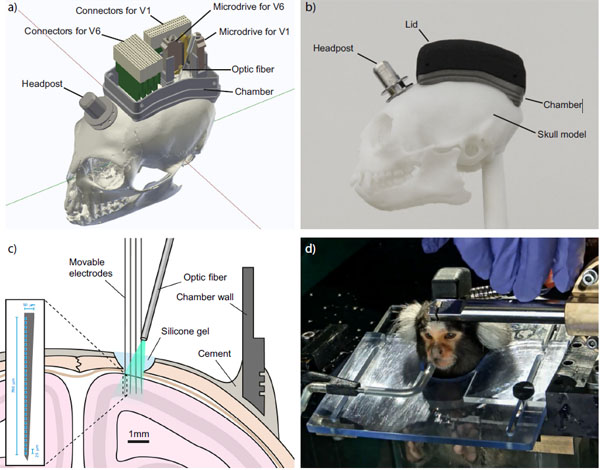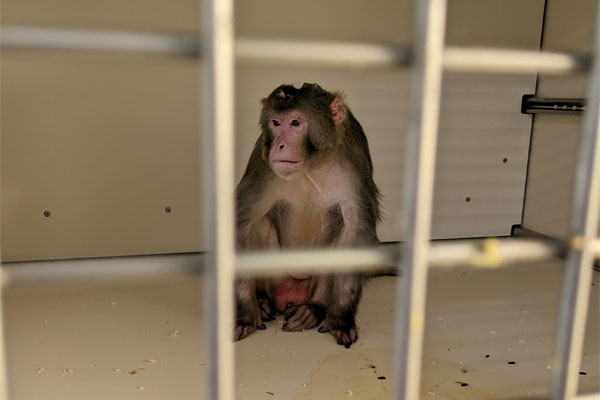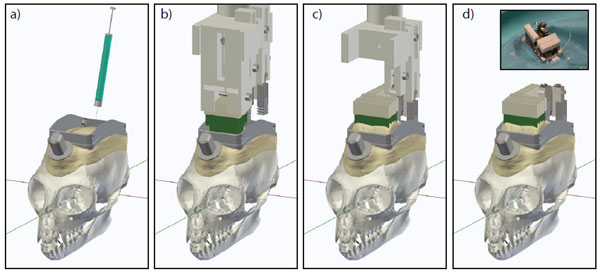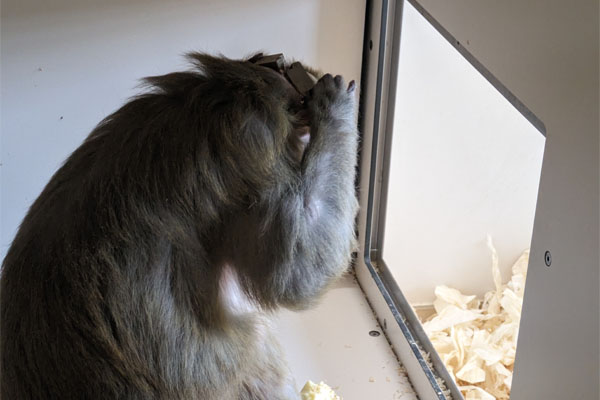Close ESI Frankfurt - Freedom for the monkeys! Save Gandalf!
Monkeys have been tortured in brain research at the Ernst Strüngmann Institute (ESI) in Frankfurt for over a decade. Macaques (both rhesus and long-tailed macaques) and common marmosets often suffer for incredibly long periods (10-20 years) in so-called basic research. Repeatedly, serious abuses have been reported from the laboratory. There is even a lack of legally required staff specialised in non-human primates. Pictures taken by a whistleblower now make the suffering of the animals visible. Together with SOKO Tierschutz and other organisations, we are calling for the laboratory to be closed and the monkeys to be relocated to specialised sanctuaries. Furtermore, the rats and mice, who are also being kept at the ESI, need to be placed in good hands as well.
What is done to the animals at the ESI and why?
The Ernst Strüngmann Institute is one of 8 institutions in Germany (alongside facilities in Bremen, Göttingen, Magdeburg, Marburg, and 3 institutes in Tübingen) that carry out neurological research on non-human primates. It is usually rhesus monkeys who suffer in this particularly cruel research. In Magdeburg, also long-tailed macaques are being used. The ESI uses common marmosets as well and stopped using cats a few years ago. The aim is to find out basic information about the nerve connections of the brain. Sometimes, research into Alzheimer's, Parkinson's or other human diseases is used as an excuse to justify the experiments. However, basic research is nothing else than purely curiosity-driven research that doesn't offer any benefit for patients suffering from these diseases.

A huge structure on the delicate skull of a common marmoset at the Ernst Strüngmann Institute.
Ref.: Jendritza P. et al. Nature communications 2023;14:577
Non-human primates
Around 17 rhesus monkeys, 1 long-tailed macaque, and 20 common marmosets are currently kept at the ESI. A metal headpost and a recording chamber are screwed onto the animals' skulls through drill holes. In the case of the small common marmosets in particular, the apparatus is almost as large as the skull itself, as pictures from a published paper show. The monkey Jara, who died in similar experiments in Tübingen, is documented as having over 20 drill holes in his skull. The animals are forced to endure unbelievable ordeals. During the test period, almost every day, they have to sit in a primate chair with their necks fixed and stare at a screen. When certain symbols appear on the monitor, they have to release a lever. If they complete a task according to the researchers' wishes, the rhesus monkeys are given a small amount of liquid. Normally, the animals are not given anything to drink outside of the experiments to keep them sufficiently thirsty to be "co-operative". In the case of the common marmosets, a tiny amount of gum arabicum is used as a "reward". The animals are forced to "co-operate" by being deprived of food.
Some of the monkeys at the Ernst Strüngmann Institute have been suffering in neurological experiments for 10 to 20 years. The monkeys Gandalf, Rhea, Lenny and Homer have even been suffering for more than 20 years.

Can you call this life? Rhesus monkey Gandalf at the Ernst Strüngmann Institute.
Ref.: SOKO Tierschutz

Further Information
Descriptions of animal experiments at the ESI (in German) >>
Cats
Until 2021, neurological experiments on cats have been published in scientific journals. To our knowledge, cats are currently no longer kept at the ESI.
Mice and rats
Mice and rats also have bulky implants anchored to their skulls through drill holes. Mice are forced to "co-operate" through starvation. For example, their head is fixed with a head post in a way to make them stand on a large ball. They have to walk on the ball and move through virtual reality. At the same time, their facial expressions are recorded and the results are compared with those of rhesus monkeys.

Mouse at the ESI with a bulky implant on the head.
Ref.: SOKO Tierschutz
Abuses at the ESI
In January 2023, whistleblowers approached Doctors Against Animal Experiments (DAAE) and other associations to point out animal welfare violations at the ESI. For example, monkeys were being dehydrated but not "used" in experiments and thus not "rewarded" with fluids. They were kept thirsty. Many animals remained in solitary confinement for months or even years and the operations on the monkeys' skulls were carried out by inexperienced surgeons.
We approached various authorities with this information. After the abuses were initially vehemently denied, the Ministry of Science finally admitted them to DAAE in July 2023 and announced their immediate cessation as well as necessary consequences. The new information now shows that no adequate steps have been taken to put an end to the abuses.
At the beginning of 2024, whistleblowers informed DAAE about staff problems: both the veterinarian specialised in primates and the head of the animal facility resigned from their positions at the end of February 2024. The positions have not yet been filled. The current experiment and animal housing licences should therefore have been revoked immediately, as the applicable animal welfare legislation explicitly requires specialised veterinarians to care for animals kept for experimental purposes. Instead, according to information from whistleblowers, the responsible authority - the Darmstadt Regional Council - is apparently content with the ESI temporarily refraining from conducting animal experiments. We filed a criminal complaint against the responsible authority in April 2024.
Another insider has now brought images to the public via the organisation SOKO Tierschutz showing the harrowing everyday life of the animals kept at the ESI.

Over 20 years with equipment bolted to his skull: rhesus monkey Homer at the ESI.
Ref.: SOKO Tierschutz
Funding of the ESI
Founded in 2012, the Ernst Strüngmann Institute (ESI) utilised the premises of the Max Planck Institute for Brain Research (MPI) in Frankfurt, where monkeys, cats, and other animals had already been subjected to horrific suffering for at least 30 years. The founders Andreas and Thomas Strüngmann, who named the institute after their father, financed the establishment of the ESI with 200 million euros (1). The state of Hesse added 30 million euros for a new building on the campus Frankfurt Niederrad (2). The institute relocated to the new building in 2018 and is otherwise financed by the income of the Ernst Strüngmann Foundation.
Help us to close down animal facility at the ESI!
10 or 20 years with harrowing apparatuses on their skulls is enough! We demand that the 38 monkeys as well as all rats and mice be placed in appropriate sanctuaries. New licences are no longer to be granted and the research on animals at the ESI must be stopped immediately for good!
We have prepared an email to those responsible. Please help us and share this appeal widely! (in German)

Demo
IMPORTANT! Please join us at the demo in Frankfurt, Germany, on 6th July. Further Information (in German) >>
References
(1) Stifter spenden Max Planck ein Institut. Tagesspiegel.de, 22.07.2008
(2) Millionen fürs Hirn. Frankfurter Rundschau, 19.01.2019
